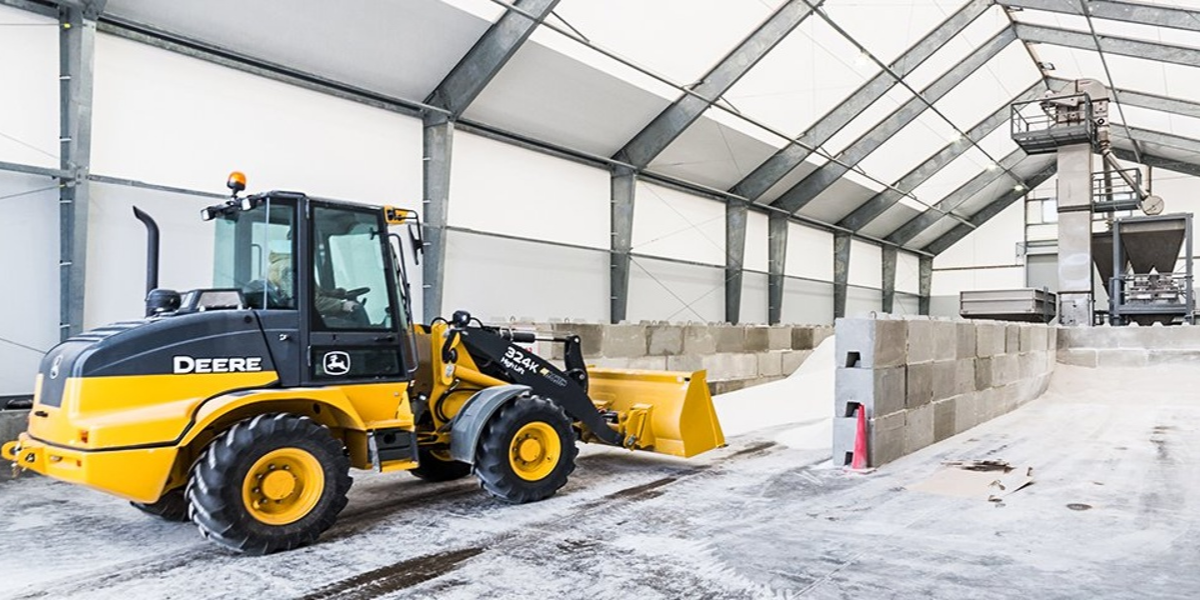Custom Design & Build: Legacy's Bulk Salt Storage

When storing bulk materials, including road salt, frac sand, fertilizer or agricultural commodities, there are two primary storage methods: horizontal (covered or uncovered) and vertical (silos, bins).
Although both storage methods are widely used, bulk flat storage has several advantages over vertical storage solutions, including:
- Increased capacity
- Flexibility for multiple operations
Increased Capacity for Bulk Storage
Bulk storage buildings have greater capacity than vertical bins and silos. Open space leaves plenty of room for piles. By varying pile height and configuration, flat storage buildings have higher capacity than vertical grain storage structures.
Building design can increase storage capacity to meet fertilizer storage requirements. For example, using cast-in-place or precast concrete panels to form bins allows the piles of material to extend to the very edges of the building.
Clearspan design is another way to increase capacity for flat storage buildings. Interior columns take up valuable floor space that would be better occupied by stored material, and they create obstacles for handling equipment maneuvering in the building.
Take a video tour of a clearspan fabric building that increased capacity for the end user.
True clearspan space also means equipment is off the ground. With the flexibility of a rigid-framed building, conveyors, conditioning equipment and ventilation can be suspended from the building frame -- making the building more efficient and practical.
An open floor plan also allows for future growth and business expansion. Changing the amount, number and type of product you store requires just a change in configuration, as opposed to adding a new silo or bin.
Flexibility for Fertilizer Handling Operations
Unlike silos or vertical storage options, fabric buildings can be used for a variety of business operations.
Few businesses are purely devoted to storage. Enclosed flat storage buildings have space for handling, blending, maintenance, retail and even office space. Covering these operations creates a superior work environment and keeps moisture off stored product during loading.
This retail facility handles both bagged and bulk product.
The open space and design flexibility of a fabric flat storage building also allows for storing multiple products, or separate areas for bulk and bagged products. Bagging and packing can be done under the membrane cover for increased efficiency, protection and maintaining product quality.
Flat Storage Building Ventilation
Flat storage solutions have multiple options for ventilation, which is required for maintaining the best environment for stored commodities.
Excess moisture can cause materials to clump or spoil. The best way to prevent this moisture build-up is to create a constant flow of air inside the building. Legacy’s rigid frame design allows for eave intake and ridge vents, which use the properties of gravity to create air circulation inside the building.
Eave intakes allow fresh air to flow in closer to the level of stored product, while moist air moves closer to the ceiling building before being exhausted out the top. For an in-depth view of overhangs or eave intakes that ventilate the entire length of the building, click here.
For storage facilities with higher ventilation requirements, active ventilation systems are available to produce the required number of air-turns per hour.
Flat storage solutions have advantages for storage space, flexibility and ventilation. For information specific to your bulk storage needs, contact us.
Flat Storage Buildings for Bulk Materials: FAQs
Flat storage uses horizontal, open or enclosed buildings to store bulk materials like road salt, fertilizer, frac sand, and agricultural commodities, while vertical storage relies on silos or bins. Flat storage buildings offer greater usable capacity, easier material handling, and more flexibility for changing products or operations compared to fixed-capacity vertical systems.
Flat storage buildings maximize capacity by using open floor space without interior columns, allowing material to be piled freely. Storage volume can be increased by adjusting pile height and configuration, and concrete bin walls can extend piles to the full width of the building. Clearspan designs also allow equipment like conveyors and ventilation systems to be suspended overhead, keeping floor space fully usable.
Yes. Flat storage buildings are highly adaptable and can support multiple operations beyond storage, including blending, bagging, packing, maintenance, retail areas, and even office space. The open layout allows operators to store multiple products under one roof or reconfigure the space as business needs change, without adding new silos or permanent structures.
Moisture control in flat storage buildings is achieved through passive or active ventilation systems. Passive ventilation uses eave intakes and ridge vents to create continuous airflow, drawing fresh air in near stored material while allowing moist air to exhaust upward. For facilities with higher airflow requirements, mechanical ventilation systems can be added to achieve the necessary air turnover and protect material quality.
Subscribe to our Blog
Recent Posts
- 5 Factors Every Project Owner Should Consider Before Approving Building Materials
- The 20-Year View: How Material Choices Impact Long-Term Operational Costs
- Climate Resilience in Commercial Construction: Why Traditional Methods May Not Be Enough
- Speed and Quality: The Role of Hybrid Building Materials
- Beyond the Bleachers: Designing Visually Striking Sports Facilities

